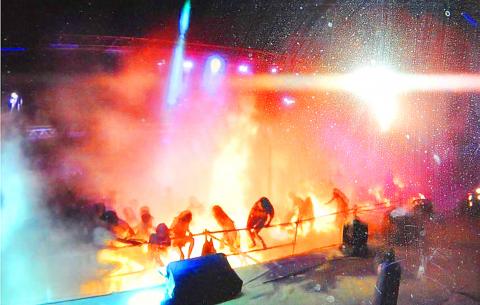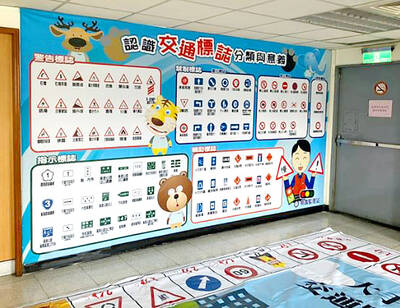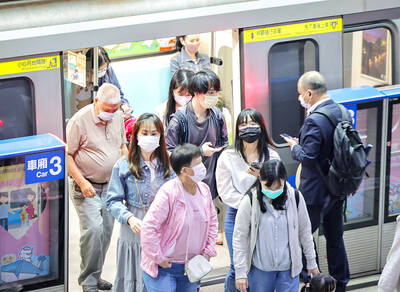Amid shock and confusion over the fire that broke out late on Saturday at the Formosa Fun Coast (八仙海岸) park in New Taipei City’s Bali District (八里), footage reportedly taken by a woman who witnessed the incident gives a visceral account of how a techno party turned into a fiery inferno.
The Chinese-language Apple Daily on Saturday night posted footage taken by a woman surnamed Huang (黃), who said she happened to be close to the scene of the fire.
The two-minute-long video showed people attending the “Color Play Asia” party dancing to techno music as a line of congo dancers moved through the crowd.

Photo courtesy of the New Taipei City Fire Department
Moments later, colored powders were sprayed from the stage and quickly covered the revelers and an initial explosion occurred, igniting the powder, the footage showed.
A second, larger explosion followed almost immediately, creating an enormous blaze of light and sending flames across the dance floor, it showed.
People began screaming and running from the dance floor, with many falling and being trampled in the stampede, the footage showed.
A creative marketing team named Simpleinfo (圖文不符) yesterday posted information on Facebook to raise awareness about dust explosions, the purported cause of the fire.
According to the team, dust explosions are chain reactions set off by high-density dust ignited by a spark or other source of heat.
With enough oxygen, a cloud of dust can combust and cause an explosion, the team said.
The initial explosion at the park created a vacuum, which sucked in more dust, triggering a second, more powerful blast, it said.
As smaller dust particles are more likely to combust, some substances are more volatile than others, such as metal powder, flour and dye, the team said.
The chance of dust explosions increase in high-pressure environments, such as basements, where materials that are traditionally viewed as slow-burning, such as some types of wood, or inflammable, such as aluminum, can be volatile in powder form, it added.
Common heat sources that trigger dust explosions include static electricity, friction between dust particles, electric arcs sometimes associated with household appliances, flames and anything that is hot.
The team said people can help to prevent dust explosions by reducing dust, improving ventilation and monitoring heat sources.
According to the Ministry of Health and Welfare, and the Ministry of Foreign Affairs, among the injured were four people from Hong Kong, one from Macau, two Chinese, two Japanese, one Malaysian, one Singaporean, one white male of unknown nationality and one unidentified person.
The four Hong Kongers are: Chan Hiu-yin (陳曉妍), Lee Yee-lam (李宜霖), Chau Wing-shan (周穎珊) and Mok Tsz-ching (莫子青), all female.
The Hong Kong Immigration Department and the New Taipei City Department of Health said five Hong Kongers were injured in the incident, but no name was available for the fifth.
The injured Macanese is Yip Kai-tung (葉紀彤). The two Chinese, also female, are: Chen Lingdan (陳靈丹) and Zhuang Chujun (莊楚君).
The Singaporean was identified as Megan Loy, while the Malaysian woman is Lin Shili (林詩例).
The white male of unknown nationality has been named as Alex Haas, while the person of unknown nationality was only identified as Fouri, but no gender was given.
The names of the two Japanese females were yet to be released.
Additional reporting by CNA

GAINING STEAM: The scheme initially failed to gather much attention, with only 188 cards issued in its first year, but gained popularity amid the COVID-19 pandemic Applications for the Employment Gold Card have increased in the past few years, with the card having been issued to a total of 13,191 people from 101 countries since its introduction in 2018, the National Development Council (NDC) said yesterday. Those who have received the card have included celebrities, such as former NBA star Dwight Howard and Australian-South Korean cheerleader Dahye Lee, the NDC said. The four-in-one Employment Gold Card combines a work permit, resident visa, Alien Resident Certificate (ARC) and re-entry permit. It was first introduced in February 2018 through the Act Governing Recruitment and Employment of Foreign Professionals (外國專業人才延攬及雇用法),

RESILIENCE: Deepening bilateral cooperation would extend the peace sustained over the 45 years since the Taiwan Relations Act, Greene said Taiwan-US relations are built on deep economic ties and shared values, American Institute in Taiwan (AIT) Director Raymond Greene said yesterday, adding that strengthening supply chain security in critical industries, enhancing societal resilience through cooperation and deepening partnerships are key to ensuring peace and stability for Taiwan in the years ahead. Greene made the remarks at the National Security Youth Forum, organized by National Taiwan University’s National Security and Strategy Studies Institution in Taipei. In his address in Mandarin Chinese, Greene said the Taiwan-US relationship is built on deep economic ties and shared interests, and grows stronger through the enduring friendship between

The Ministry of Transportation and Communications yesterday said that it would redesign the written portion of the driver’s license exam to make it more rigorous. “We hope that the exam can assess drivers’ understanding of traffic rules, particularly those who take the driver’s license test for the first time. In the past, drivers only needed to cram a book of test questions to pass the written exam,” Minister of Transportation and Communications Chen Shih-kai (陳世凱) told a news conference at the Taoyuan Motor Vehicle Office. “In the future, they would not be able to pass the test unless they study traffic regulations

‘COMING MENACINGLY’: The CDC advised wearing a mask when visiting hospitals or long-term care centers, on public transportation and in crowded indoor venues Hospital visits for COVID-19 last week increased by 113 percent to 41,402, the Centers for Disease Control (CDC) said yesterday, as it encouraged people to wear a mask in three public settings to prevent infection. CDC Epidemic Intelligence Center Deputy Director Lee Chia-lin (李佳琳) said weekly hospital visits for COVID-19 have been increasing for seven consecutive weeks, and 102 severe COVID-19 cases and 19 deaths were confirmed last week, both the highest weekly numbers this year. CDC physician Lee Tsung-han (李宗翰) said the youngest person hospitalized due to the disease this year was reported last week, a one-month-old baby, who does not